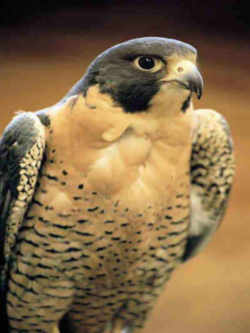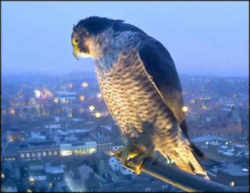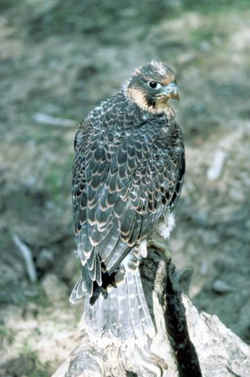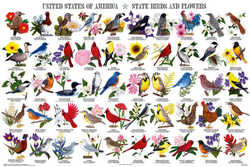Idaho State Raptor
Peregrine Falcon (Duck Hawk, Great-footed Hawk, and Wandering Falcon)

(Falco peregrinus)
Adopted in 2004.
The Peregrine Falcon, (Falco peregrinus,) was adopted as the state raptor for Idaho by the legislature in 2004. The scientific name comes from the Latin words Falco, meaning hook-shaped (falcate) and may refer to the beak or claws, and peregrinus, meaning to wander. Peregrines have also been called Duck Hawk, Great-footed Hawk, and Wandering Falcon.
Idaho is the only state that has adopted an official raptor and it was done with the help of fourth-grade students from Peregrine Elementary School
in Meridian and from St. Joseph's Elementary School in Boise.
As a result of the efforts of the students, House Bill No. 712, to adopt the peregrine falcon as the official raptor of Idaho, was introduced and read
for the first time on February 16, 2004 and was read for the required 3rd time and approved by the House ten days later on February 26, and approved
unanimously by the Senate on March 19, 2003.
Governor Dick Kempthorne signed the legislation adopting the peregrine falcon as Idaho's "... state raptor of the state of Idaho."
Idaho State Raptor: Peregrine Falcon

This crow-sized falcon is admired for its incredible speeds which are seldom exceeded by any other bird. Plunging from tremendous heights, the peregrine falcon clocked it diving at speeds of over 200 mph in pursuit of prey. It feeds primarily on birds, which it takes on the wing.
Characteristics of the Peregrine Falcon
Adult peregrines are slate-grey above and pale below, with fine dark bars and spots on their underparts. Both adults and immature have a wide, dark "moustache" mark below the eye. The tail is narrow and the wings long and pointed. Juveniles are brown overall, with dark streaking below. Airborne, this falcon can be recognized by characteristic rapid wing beats interspersed with long glides.
The Peregrine Falcon has one of the most global distributions of any bird of prey. This falcon is found on every continent except Antarctica, and lives in a wide variety of habitats from tropics, deserts, and maritime to the tundra, and from sea level to 12,000 feet. Peregrines are highly migratory in the northern part of their range.
Though making an extraordinary comeback after the banning of DDT and conservation actions by many organizations and individuals, the Peregrine Falcon is still not very common in Idaho. According to the Idaho Fish and Game Department, fewer than 30 historic nesting sites for these species were ever identified. Despite the fact that a pair is nesting on a tall building in downtown Boise, populations within Idaho are found mostly in the central and eastern portion of the state.
Did you Know?
- The Peregrine Falcon is famous for its fast flying. Biologists have clocked it diving at speeds of over 200 mph. That's about as fast as a race car goes!
- These falcons have adapted well to life in large cities, where they feed on birds like pigeons and starlings, and nest on the ledges of tall buildings.
- Like many raptors, Peregrine Falcon females are larger than the males.
- The Peregrine Falcon was removed from the Endangered Species list in 1999, thanks to efforts by The Peregrine Fund and many other organizations and individuals.
Common Name of the Peregrine Falcon
Peregrines have also been called Duck Hawk, Great-footed Hawk, and Wandering Falcon.
Life History

Peregrine falcons generally return to the same nesting territory annually and mate for life. The courtship flight is a spectacular sight. The pair climbs high in the air and performs a precise acrobatic act of whirling spirals and steep rapid dives, often touching in midair. The average clutch consists of three to four eggs which hatch after an incubation period of 29-32 days. The single brood fledges after 35-42 days. Both parents participate in incubation and brooding activities, but the female remains at the nest for the majority of the time while the male hunts and brings food to her and the young. Young falcons may stay in the area for about six weeks after they fledge, developing their flying and hunting skills. Sexual maturity is generally reached at two years of age, but one-year-olds have been known to produce young. Individuals may live as long as 20 years.
Idaho Statute
The law designating the Peregrine Falcon as the official Idaho state raptor is from Section 67-4512 (STATE RAPTOR DESIGNATED) of the Idaho Statutes, Title 67 (STATE GOVERNMENT AND STATE AFFAIRS) Chapter 45 (STATE SYMBOLS) Section 67-4512.
TITLE 67. STATE GOVERNMENT AND STATE AFFAIRS.
CHAPTER 45. STATE SYMBOLS.
SECTION 67-4512
67-4512. STATE RAPTOR DESIGNATED. The Peregrine Falcon is hereby designated and declared to be the state raptor of the state of Idaho.
Taxonomic Hierarchy: Peregrine Falcon
Kingdom: Animalia - animals
Phylum: Chordata - chordates
Subphylum: Vertebrata - vertebrates
Class: Aves - birds
Order: Falconiformes
Family: Falconidae
Genus: Falco
Species: F. peregrinus








